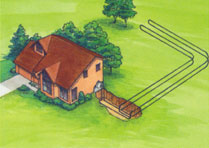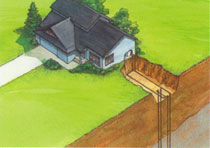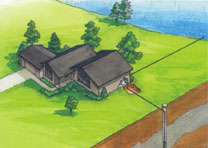Geothermal Loop Systems
We specialize in the installation of Geothermal ground loop systems. There are several options for geothermal loop systems. The most popular system is the closed loop system. These systems can be done in several different ways, but most common are the horizontal and vertical systems.
Horizontal Systems
Our horizontal systems are generally accomplished by doing a "race track" loop. To do this, we run two 1.25 inch heat fusion polyethylene header pipes from the unit in the house to the loop field which can be up to 200 feet away. One pipe supplies and the other returns. Once we reach the loop field we branch off of the supply header pipe into several .75 inch by 600 feet heat fusion polyethylene pipes, which run 300 feet out and then 300 feet back to the return header, all in one trench with an eight feet minimum depth. The number of pipes in each loop depends on the size of the system, which in turn effects the width of our trench which can vary from eight feet to 14 feet depending on the system size. However, the length of the trench will remain the same, at 300 feet.
 |
Used when adequate land is available, horizontal loops involve trenches that are dug using a backhoe or chain trencher. Polyethylene popes are inserted, and the trenches are backfilled. A typical home requires ¼ to ¾ of an acre for the trenches. |
Vertical Systems
Vertical systems share the same concept as horizontal loops in which still utilize two 1¼ inch header pipes, but instead of running horizontally 300 feet, we drill 200 feet straight down. A set of ¾ inch heat fusion polyethylene pipes with a "U" bend installed at one end are pushed 200 feet down to the bottom of the drilled hole. Once the pipe is installed, the holes are filled with a grout mixture. Although vertical loops are more expensive to install than horizontal loops, they are ideal for homes that do not have the open area to do a horizontal loop.
Vertical loops are used when space is limited. Holes are bored using a drilling rig, and a pair of pipes with special u-bend fittings is inserted into the holes. A typical home requires three to five bores with about a 15-foot separation between the holes. |
 |
Well Water Systems
A well water system utilizes the existing well to pump water from the well to the heat pump. The water is then circulated through the heat pump's heat exchanger and discharged into a drain field. The drain field can either be above ground or below ground using infiltrators. Well water systems are the most inexpensive way to install a geothermal heat pump, but they do add stress to a well due to the high volume of water that is extracted. They also require excellent water quality to avoid damage to the geothermal system.
 |
An open loop is used where there is an adundant supply of quality well water. Ther well must have enough capacity to provide adequate flow for both domestic use and the WaterFurance unit. units require 3-10 gallons per minute, depending on size. |
|
